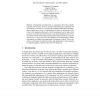Free Online Productivity Tools
i2Speak
i2Symbol
i2OCR
iTex2Img
iWeb2Print
iWeb2Shot
i2Type
iPdf2Split
iPdf2Merge
i2Bopomofo
i2Arabic
i2Style
i2Image
i2PDF
iLatex2Rtf
Sci2ools
CD
2004
Springer
2004
Springer
Keeping Control of Reusable Components
Development and deployment via components offers the possibility of prolific software reuse. However, to achieve this potential in a component-rich environment, it is necessary to recognize that component deployment (and subsequent composition) is closer to a continual process than a one-off operation. This is due to the requirement that newly-evolved components need to replace their ancestors in a timely and efficient manner at the client deployment sites. Modern runtime systems which employ dynamic link-loading mechanisms can permit such dynamic evolution. We review the capabilities of several alternative runtime environments to establish some requirements for dynamic evolution. Then we describe a tool designed to support developers and administrators in the migration of component updates within the Microsoft .NET framework.
CD 2004 | Client Deployment Sites | Dynamic Evolution | Programming Languages | Prolific Software Reuse |
| Added | 01 Jul 2010 |
| Updated | 01 Jul 2010 |
| Type | Conference |
| Year | 2004 |
| Where | CD |
| Authors | Susan Eisenbach, Dilek Kayhan, Chris Sadler |
Comments (0)

